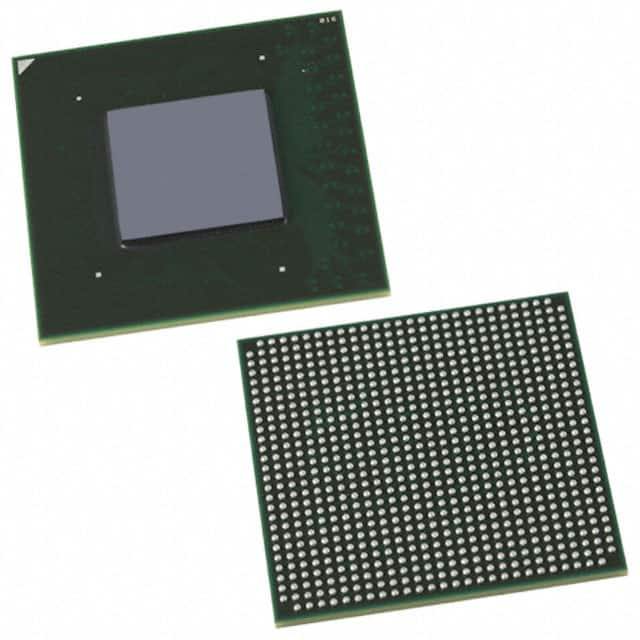Lihat spesifikasi untuk detail produk.

EP2AGX125EF29C5
Basic Information Overview
- Category: Programmable Logic Device (PLD)
- Use: EP2AGX125EF29C5 is a PLD used for digital logic design and implementation.
- Characteristics:
- High-performance FPGA (Field-Programmable Gate Array) device
- Low power consumption
- Large capacity for complex designs
- Flexible and reprogrammable
- Package: EP2AGX125EF29C5 comes in a compact and durable package suitable for integration into various electronic systems.
- Essence: EP2AGX125EF29C5 is designed to provide a versatile and efficient solution for implementing complex digital logic circuits.
Specifications
- Logic Elements: 125,000
- Embedded Memory: 4,608 Kbits
- Maximum User I/O Pins: 622
- Operating Voltage: 1.2V
- Speed Grade: -5 (operating frequency up to 500 MHz)
- Package Type: FBGA (Fine-Pitch Ball Grid Array)
- Package Pins: 780
Detailed Pin Configuration
EP2AGX125EF29C5 has a total of 780 pins, which are divided into different categories: - I/O Pins: Used for input/output connections with external devices. - Dedicated Clock Pins: Used for clock signal inputs. - Configuration Pins: Used for programming and configuration purposes. - Power Supply Pins: Provide the necessary voltage levels for proper operation.
For a detailed pin configuration diagram, please refer to the manufacturer's datasheet.
Functional Features
- High-Speed Performance: EP2AGX125EF29C5 offers high-speed operation, making it suitable for applications requiring real-time processing.
- Flexibility: The device can be reprogrammed multiple times, allowing for iterative design improvements and adaptability to changing requirements.
- Integration: EP2AGX125EF29C5 can integrate multiple functions and complex logic circuits into a single device, reducing the need for additional components.
- Low Power Consumption: The PLD is designed to minimize power consumption, making it suitable for battery-powered devices.
Advantages and Disadvantages
Advantages: - High-performance FPGA with large capacity - Flexible and reprogrammable nature - Low power consumption - Integration of multiple functions
Disadvantages: - Complexity in design and implementation - Higher cost compared to simpler logic devices - Requires specialized knowledge for programming and configuration
Working Principles
EP2AGX125EF29C5 utilizes programmable logic elements and interconnects to implement digital logic circuits. The device consists of configurable logic blocks (CLBs), embedded memory blocks, I/O elements, and other supporting components. Users can program the PLD using hardware description languages (HDL) or graphical tools to define the desired functionality. Once programmed, the device operates based on the configured logic and interconnections.
Detailed Application Field Plans
EP2AGX125EF29C5 finds applications in various fields, including: 1. Telecommunications: Used in network infrastructure equipment, such as routers and switches, for high-speed data processing and protocol handling. 2. Industrial Automation: Employed in control systems for factory automation, robotics, and process control, enabling real-time monitoring and control of industrial processes. 3. Aerospace and Defense: Utilized in avionics systems, radar signal processing, and secure communication systems, providing high-performance computing capabilities. 4. Medical Devices: Integrated into medical imaging equipment, patient monitoring systems, and diagnostic instruments, facilitating advanced signal processing and data analysis. 5. Automotive: Used in automotive electronics for engine control units (ECUs), advanced driver-assistance systems (ADAS), and infotainment systems, enhancing vehicle performance and safety.
Detailed and Complete Alternative Models
- EP2AGX190EF29C5: Similar to EP2AGX125EF29C5 but with higher logic capacity and more I/O pins.
- EP4CE115F29C7: An alternative PLD from a different manufacturer, offering similar features and performance.
- XC7A100T-2FGG484C: Another FPGA device with comparable specifications, suitable for various digital design applications.
Note: Please refer to the manufacturers' datasheets for detailed information on alternative models.
Word count: 540 words
Sebutkan 10 pertanyaan dan jawaban umum terkait penerapan EP2AGX125EF29C5 dalam solusi teknis
Sure! Here are 10 common questions and answers related to the application of EP2AGX125EF29C5 in technical solutions:
Q: What is EP2AGX125EF29C5? A: EP2AGX125EF29C5 is a specific model of FPGA (Field-Programmable Gate Array) manufactured by Intel.
Q: What are the key features of EP2AGX125EF29C5? A: Some key features of EP2AGX125EF29C5 include high logic density, low power consumption, embedded memory blocks, and support for various I/O standards.
Q: In what applications can EP2AGX125EF29C5 be used? A: EP2AGX125EF29C5 can be used in a wide range of applications such as telecommunications, industrial automation, automotive electronics, and medical devices.
Q: How can EP2AGX125EF29C5 be programmed? A: EP2AGX125EF29C5 can be programmed using hardware description languages (HDLs) like VHDL or Verilog, along with design software provided by Intel.
Q: What is the maximum number of logic elements supported by EP2AGX125EF29C5? A: EP2AGX125EF29C5 supports up to 125,000 logic elements, which can be used to implement complex digital circuits.
Q: Does EP2AGX125EF29C5 support high-speed serial interfaces? A: Yes, EP2AGX125EF29C5 supports high-speed serial interfaces like PCIe, Gigabit Ethernet, and USB, making it suitable for applications requiring fast data transfer.
Q: Can EP2AGX125EF29C5 be reprogrammed after deployment? A: Yes, EP2AGX125EF29C5 is a reprogrammable FPGA, allowing for updates and modifications to the implemented logic even after deployment.
Q: What are the power requirements for EP2AGX125EF29C5? A: EP2AGX125EF29C5 operates at a typical voltage of 1.2V and requires a stable power supply capable of delivering sufficient current based on the design requirements.
Q: Are there any development boards available for EP2AGX125EF29C5? A: Yes, Intel provides development boards specifically designed for EP2AGX125EF29C5, which include necessary interfaces and connectors for prototyping and testing.
Q: Can EP2AGX125EF29C5 interface with other components or microcontrollers? A: Yes, EP2AGX125EF29C5 can interface with other components or microcontrollers using various communication protocols such as SPI, I2C, UART, or custom interfaces implemented in the FPGA design.
Please note that the specific details and answers may vary depending on the context and application requirements.

